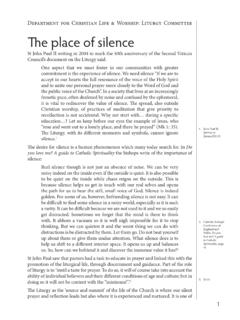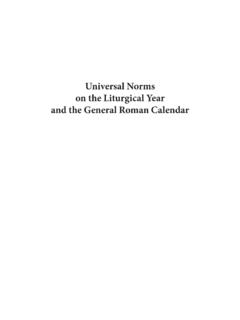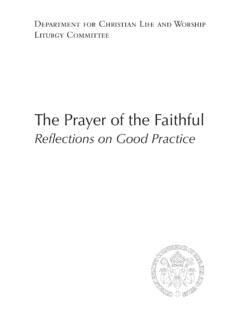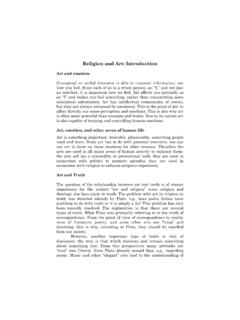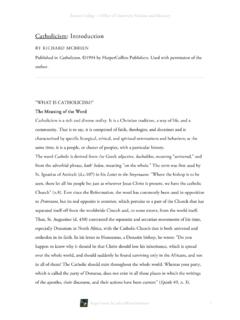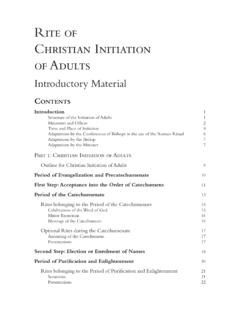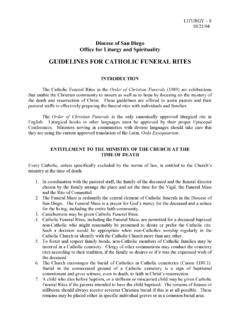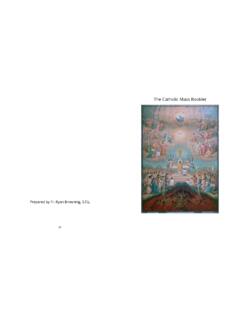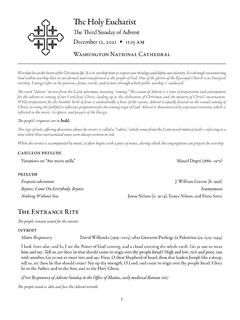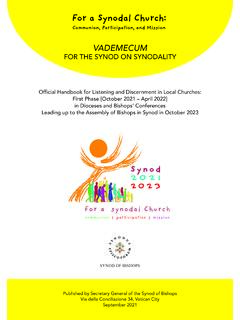Transcription of Dedication of a Church and an Altar - Liturgy Office
1 Rite of Dedication of a Church and an Altar , Introductions Dedication of a Church and an AltarIntroductionsContents Decree 2 Chapter One Laying of a Foundation Stone or Commencement of Work on the Building of a Church 3 Chapter Two Dedication of a Church 5 Chapter Three Dedication of a Church Already in General Use for Sacred Celebrations 13 Chapter Four Dedication of an Altar 15 Chapter Five Blessing of a Church 23 Chapter Six Blessing of an Altar 25 Chapter Seven Blessing of a Chalice and Paten 27 Rite of Dedication of a Church and an Altar English translation 1978, International Committee on English in the Liturgy , Inc. (ICEL) All rights reserved. One of a series of resources from i t u r g yO f f i c eEN G L A ND& WA L E S Rite of Dedication of a Church and an Altar , IntroductionssaCred Congregation for the saCraments and divine WorshipProt.
2 No. CD 300/77deCreeThe rite for the Dedication of a Church and an Altar is rightly considered among the most solemn liturgical services. A Church is the place where the christian community is gath-ered to hear the word of God, to offer intercession and praise to him, and above all to celebrate the holy mysteries, and it is the place where the holy sacrament of the eucharist is kept. Thus it stands as a special kind of image of the Church itself, which is God s temple built from living stones. And the Altar of a Church , around which the holy people of God gather to take part in the Lord s sacrifice and to be refreshed at the heavenly meal, stands as a sign of Christ himself, who is the priest, the victim, and the Altar of his own rites, found in the second book of the Roman Pontifical, were revised and simpli-fied in 1961. Nevertheless it was judged necessary to revise the rites again and to adapt them to contemporary conditions in view of the purpose and the norms of the liturgical reform that Vatican II set in motion and Paul VI by his authority has approved the new Ordo dedicationis ecclesiae et altaris pre-pared by the Congregation for the Sacraments and Divine Worship.
3 He has ordered it to be published and prescribed that it replace the rites now in the second book of the Roman Congregation, by mandate of the Pope, therefore publishes this Ordo dedicationis ec-clesiae et altaris. In the Latin text it will be in effect as soon as it appears; in the vernacular, it will take effect, after the translations have been confirmed and approved by the Apostolic See, on the day determined by the conferences of to the contrary the Office of the Congregation for the Sacraments and Divine Worship, May 29, 1977, Pentecost.+ James R. Cardinal Knox Prefect+ Antonio Innocenti Titular Archbishop of Eclano SecretaryRite of Dedication of a Church and an Altar , Introductions Chapter onerite of Laying the foundation stone or Beginning Work on the BuiLding of a ChurChIntroduction1. When the building of a new Church begins, it is desirable to celebrate a rite to ask God s blessing for the success of the work and to remind the people that the structure built of stone will be a visible sign of the living Church , God s building that is formed of the peo-ple accordance with liturgical tradition, this rite consists of the blessing of the site of the new Church and the blessing and laying of the foundation stone.
4 When there is to be no foundation stone because of the particular architecture of the building, the rite of the blessing of the site of the new Church should still be celebrated in order to dedicate the beginning of the work of The rite for the laying of a foundation stone or for beginning a new Church may be cel-ebrated on any day except during the Easter triduum. But the preference should be for a day when the people can be present in large The bishop of the diocese is rightly the one to celebrate the rite. If he cannot do so him-self, he shall entrust the function to another bishop or a priest, especially to one who is his associate and assistant in the pastoral care of the diocese or of the community for which the new Church is to be Notice of the date and hour of the celebration should be given to the people in good time.
5 The pastor or others concerned should instruct them in the meaning of the rite and the reverence to be shown toward the Church that is to be built for is also desirable that the people be asked to give their generous and willing support in the building of the Insofar as possible, the area for the erection of the Church should be marked out clearly. It should be possible to walk about without In the place where the Altar will be located, a wooden cross of suitable height is fixed in the For the celebration of the rite the following should be prepared:The Roman Pontifical and Lectionary;chair for the bishop;depending on the circumstances, the foundation stone, which by tradition is a rec-tangular cornerstone, together with cement and the tools for setting the stone in the foundation;container of holy water with sprinkler;censer, incense boat and spoon;processional cross and torches for the See 1 Cor 3:9; LG, 6.
6 Rite of Dedication of a Church and an Altar , IntroductionsSound equipment should be set up so that the assembly can clearly hear the readings, prayers, and For the celebration of the rite the vestments are white or of some festive color. The fol-lowing should be prepared:for the bishop: aIb, stole, cope, miter, and pastoral staff;for the priest, when one presides over the celebration: alb, stole, and cope;for the deacons: aIbs, stoles, and if opportune, dalmatics; for other ministers: albs or other lawfully approved of the RiteApproach to the Construction Site A. First Form: ProcessionGreetingBrief IntroductionPrayerProcessionB. Second Form: Station at the Construction Site of the New Church Acclamation or SongGreetingBrief InstructionPrayerReading of the Word of GodReading(s)[Responsorial Psalm]HomilyPlacing of the Document(s) in the Foundation StoneBlessing of the Site of the New Church Prayer of BlessingLaying of the Foundation StoneConcluding RiteGeneral IntercessionsLord s PrayerConcluding PrayerBlessing and Dismissal Rite of Dedication of a Church and an Altar , Introductions Chapter tWo Dedication of a ChurChIntroductionI.
7 Nature and Dignity of Churches1. Through his death and resurrection, Christ became the true and perfect temple1 of the New Covenant and gathered together a people to be his holy people, made one as the Father, Son, and Holy Spirit are one, is the Church2 that is, the temple of God built of living stones, where the Father is worshiped in spirit and in , then, from early times Church has also been the name given to the building in which the christian community gathers to hear the word of God, to pray together, to receive the sacraments, and to celebrate the Because the Church is a visible building, it stands as a special sign of the pilgrim Church on earth and reflects the Church dwelling in a Church is erected as a building destined solely and permanently for assembling the people of God and for carrying out sacred functions.
8 It is fitting that it be dedicated to God with a solemn rite, in accordance with the ancient custom of the The very nature of a Church demands that it be suited to sacred celebrations, dignified, evincing a noble beauty, not mere costly display, and it should stand as a sign and symbol of heavenly realities. The general plan of the sacred edifice should be such that in some way it conveys the image of the gathered assembly. It should also allow the participants to take the place most appropriate to them and assist all to carry out their individual functions properly. Moreover, in what concerns the sanctuary, the Altar , the chair, the lectern, and the place for the reservation of the blessed sacrament, the norms of the General Instruction of the Roman Missal are to be , the norms must be observed that concern things and places destined for the celebra-tion of other sacraments, especially baptism and Titular of a Church and the Relics of the Saints to be Placed in it4.
9 Every Church to be dedicated must a have a titular. This may be: the Blessed Trinity; our Lord Jesus Christ invoked according to a mystery of his life or a title already accepted in the Liturgy ; the Holy Spirit; the Blessed Virgin Mary, likewise invoked according to some appellation already accepted in the Liturgy ; one of the angels; or, finally, a saint inscribed in the Roman Martyrology or in a duly approved Appendix. A blessed may not be the titular without an indult of the Apostolic See. A Church should have one titular only, unless it is a question of saints who are listed together in the See Jn 2 See Cyprian, De oratione dominica 23: PL 4, 553; LG, no. 4: AAS 57 (1965) 7; ConstDecrDel See Jn 4 See GIRM, nos. 253, 257, 258, 259 267, 271, 272, 276 277. See also Roman Ritual Holy Communion and Worship of the Eucharist outside Mass, nos.
10 6 and 9 See Rite of Baptism for Children, no. 25; Rite of Penance, no. 12. Rite of Dedication of a Church and an Altar , Introductions5. The tradition in the Roman Liturgy of placing relics of martyrs or other saints beneath the Altar should be preserved, if But the following should be noted:a) Such relics should be of a size sufficient for them to be recognized as parts of hu-man bodies. Hence excessively small relics of one or more saints must not be placed beneath the ) The greatest care must be taken to determine whether the relics in question are au-thentic. It is better for an Altar to be dedicated without relics than to have relics of doubtful authenticity placed beneath ) A reliquary must not be placed upon the Altar or set into the table of the Altar ; it must be placed beneath the table of the Altar , as the design of the Altar Celebration of the DedicationMinister of the Rite6.
